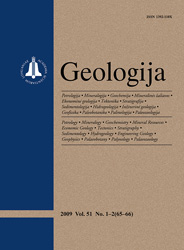Geologija / Geology
WHAT?
 ISSN 1392-110X ISSN 2029-056X (online) |
2007 m. Nr. 4 The geochemical and geoecological situation of the Gotland basin in the Baltic Sea where chemical munition was dumped
The environment of chemical munition (CM) dumpsites in the Skagerrak and in the Bornholm Basin was described in the previous publication (Emelyanov, 2007). The dumpsite of chemical munitions in the Gotland Basin is located in the southern part of the Gotland Deep. This part was named as Słupsk “River’s foredelta”. This “river” discharges suspended particulate matter into this foredelta. As a result, the layer of the Litorina mud here is the thickest in the Gotland Basin (up to 730 cm, sedimentation rate is 0.94 mm/y). From the eastern side of the foredelta there is non deposition or rewashing area, where till deposits with a thin cover of sand forms the surface of a hard bottom. Shells and bombs with poisonous matter could have been laid on the hard bottom or in the soft Litorina mud. However, we did not find any bombs or shells during our investigations. All the twenty two chemical elements we studied in the sediments were distributed according to the rule of the pelitic fraction (Emelyanov, 2005): the more the pelite (fraction < 0.01 mm) – the higher the content of the element. The maximal content of Zn (in the pelitic mud) is 39 times higer than its minimal value (in the sand), for Mn it is 416 times, for Fe – 17 times and for As – 77 times. The mean values of the elements in the pelitic mud (or clay in the western terminology) are 1.4–3.1 times higher than in the sand. The maximal content of As (which is an indicator of the hydrolysis of lewisite and mustard gas (yperite) in the surface (0–5 cm) sediments) is 32 mg/kg (10–20 mg/kg on the average), i. e. similar to the same type of mud far from the dumpsite areas. In some layers of the Litorina mud strata and in the Ancylus clay we obtained us much as 130 mg As / kg. These hightened contents were formed due to the presence of iron sulphides in these layers: the sulphides contained up to 400–450 mg As / kg. The high contents of As and other toxic elements (Cd, Pb, etc.) formed due to natural (diagenetic) processes, but not as a result of the hydrolysis of CM on the bottom. The bottom of the Southern Gotland Deep is sufficiently clean. Raktažodžiai: Gotland Deep, chemical munitions, geology, geochemistry, environment, pollution |
Issues:
2011 - Vol.53 No. 1, No. 2, No. 3 2010 - Vol.52 No. 1-4 2009 - Vol.51 No. 1-2, No. 3-4 2008 - Vol.50 No. 1, No. 2, No. 3, No. 4, No. Priedas 2007 No. 1, No. 2, No. 3, No. 4 2006 No. 1, No. 2, No. 3, No. 4 2005 No. 1, No. 2, No. 3, No. 4 2004 No. 1, No. 2, No. 3, No. 4 2003 No. 1, No. 2, No. 3, No. 4 2002 No. 1, No. 2, No. 3, No. 4 2001 No. 1, No. 2, No. 3, No. 4 |